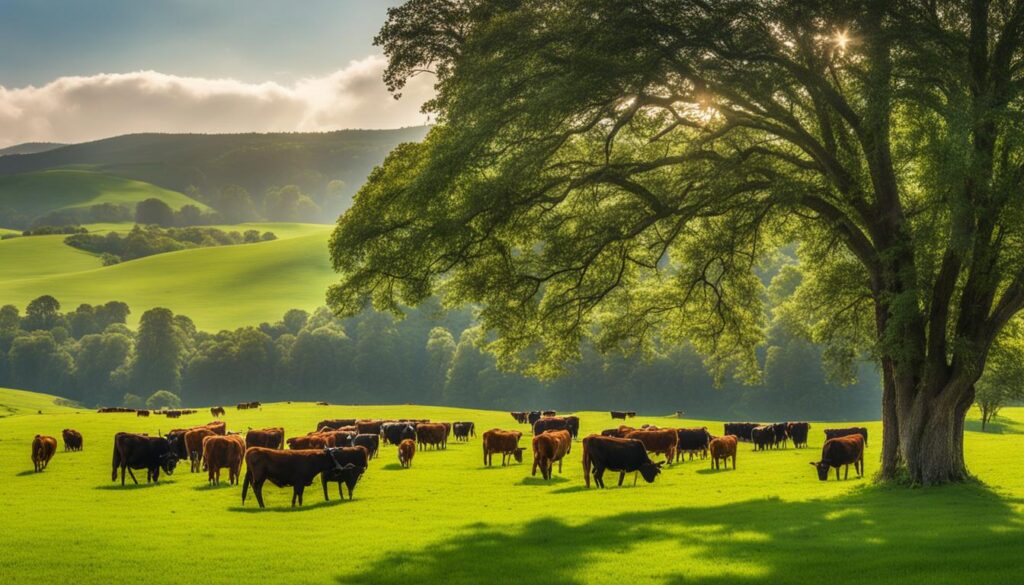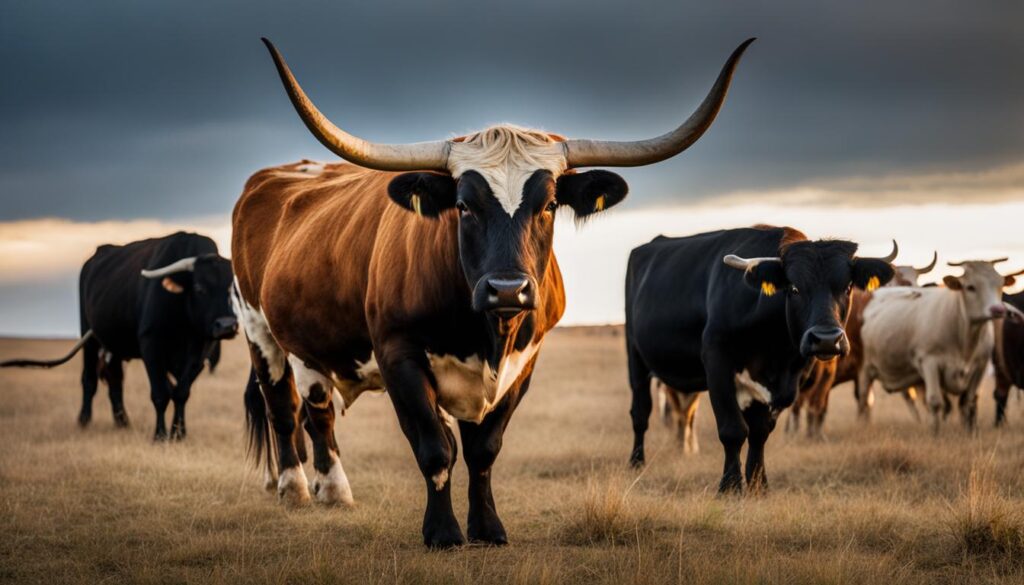Embarking on the adventure of raising Longhorn Angus Cross cattle has been one of the most rewarding experiences of my life. As a hobby farmer, I’ve found that these majestic animals offer not just a pastime but a deeply enriching way to engage with the land and contribute to our food systems. The journey is a blend of passion and pragmatism, where Longhorn Angus Cross cattle care becomes a canvas for constant learning and appreciation.
My bond with these creatures has grown 🌐 strong, rooted in the mutual respect and understanding necessary to meet their needs. In this guide, I aim to share the wisdom accrued from years of close companionship with these cattle, offering practical advice to fellow hobby farmers eager to experience the joy of our shared endeavor. Whether you’re just starting or looking to finesse your approach to raising Longhorn Angus Cross, let this be your starting point to a flourishing herd.
Key Takeaways
- Understand the unique lifestyle commitment of raising Longhorn Angus Cross.
- Learn the specific cattle care requirements that keep your herd thriving.
- Gain insight into the rewarding aspects of being a hobby farmer with this breed.
- Acquire tips on daily management to ensure the wellbeing of your Longhorn Angus Cross cattle.
- Embrace the learning curve that comes with caring for these remarkable animals.
- Discover how to contribute positively to your local food markets through responsible farming.
Understanding the Unique Traits of the Longhorn Angus Cross
The fusion of Texas Longhorn resilience and Angus breed hardiness has given rise to an exceptional bovine hybrid: the Longhorn Angus Cross. As a hobby farmer deeply invested in these cattle, I’ve had the joy of discovering their remarkable attributes first-hand. Below I delve into the fascinating aspects of their physicality, behavior in diverse conditions, and the advantageous hybrid vigor they possess.
Physical Characteristics of Longhorn Angus Cross Cattle
Longhorn Angus cross traits are as distinctive as their lineage. They boast a robust frame, a testament to the Angus’s muscular build, seamlessly integrated with the iconic horns of the Longhorn. The palette of their coats is an artist’s canvas, often mirroring the rich variety found within both progenitor breeds. It’s a harmonious combination that doesn’t just appeal to the eye, but also signals a breed of cattle that’s well-suited to a range of pastoral settings.
Behavioral Tendencies in Different Environments
Observing the angus longhorn cross characteristics in terms of behavior can be particularly fascinating. These cattle exhibit a remarkable adaptability to environmental cues. They might graze languidly on one day and energetically explore their surroundings the next. The interplay of genetics plays out in their interaction with the land and each other, painting a vivid picture of animal resilience and intelligence that never ceases to captivate.
Benefits of the Hybrid Vigor in Your Herd
The concept of hybrid vigor—or heterosis—is a vital factor to consider when managing a herd of Longhorn Angus Cross. It is this vigor that enhances their traits, including fertility and longevity, beyond what either parent breed can typically offer. The benefits for you, the hobby farmer, are manifold: healthier, more productive cattle that thrive, which translates into a more prosperous and satisfying farming experience.
| Trait | Longhorn | Angus | Longhorn Angus Cross |
|---|---|---|---|
| Horn Development | Pronounced | Polled | Diverse, less pronounced than Longhorn |
| Build | Leaner | Muscular | Robust, well-muscled |
| Coat Color | Diverse, spotted | Solid, usually black or red | Highly variable, showing both solid and mixed patterns |
| Fertility | High | High | Enhanced (Hybrid Vigor) |
| Longevity | Very Good | Good | Excellent (Hybrid Vigor) |
Caring for Your Longhorn Angus Cross Cattle: Nutrition and Health
Ensuring the optimal health of Longhorn Angus Cross cattle through nutrition and disease prevention is a cornerstone of my approach as a hobby farmer. Careful consideration of their dietary needs combined with vigilant health monitoring forms the bedrock of a thriving herd.
Optimizing Feed for Growth and Health
My Longhorn Angus Cross cattle benefit from a diet that I have fine-tuned to promote their growth and maintain their health. The intersection of the Longhorn’s efficiency and the Angus’s robust appetite requires a measured approach to nutrition—one that delivers ample energy, minerals, and vitamins.
- High-quality forages like Timothy hay for roughage
- A balance of grains for energy
- Supplements for mineral and vitamin deficiencies
Nutrition for Longhorn Angus Cross must not only satisfy hunger but also ensure a level of physical condition that supports both the Angus’s bulk and the Longhorn’s nimbleness.
Monitoring Health and Preventing Diseases
Longhorn Angus Cross cattle health is a day-to-day commitment. Being astute to the signs of distress or illness in my herd helps in preemptive identification of potential issues, allowing for prompt treatment and cattle disease prevention strategies to be implemented.
- Regular veterinary health checks
- Structured vaccination program tailored to local disease risks
- Observation for behavioral changes indicative of health issues
I maintain a close relationship with my veterinarian to establish a health care routine that includes regular vaccinations, deworming, and other preventative care measures.

| Disease | Preventative Action | Signs to Watch For |
|---|---|---|
| Bovine Respiratory Disease | Vaccinations, Adequate Ventilation | Lethargy, Coughing, Nasal Discharge |
| Foot Rot | Regular Hoof Inspections, Dry Bedding | Lameness, Swelling, Foul Smell |
| Parasites | Strategic Deworming, Pasture Management | Weight Loss, Diarrhea, Rough Coat |
| Mineral Deficiencies | Mineral Supplements, Balanced Diet | Poor Growth, Dull Coat, Reproductive Issues |
By integrating these health maintenance and disease prevention strategies into my daily management, I am able to support the longevity and productivity of my Longhorn Angus Cross cattle, ensuring they thrive under my care.
Best Practices for Breeding and Reproduction
When it comes to the art of Angus Longhorn cross breeding, I’ve learned that a careful and informed approach is key. With the goal of producing vigorous Longhorn Angus cross offspring, I’ve seen the best results when I combine expert cattle reproduction techniques with a personal touch.
Understanding that each animal is unique, I place a strong emphasis on genetic diversity. This isn’t just about improving the herd; it’s about ensuring the health and sustainability of the breed as a whole. To facilitate this, I meticulously track the breeding cycles, prioritizing the health and fertility of both the bull and the cow. Below, I’ve compiled some strategies that have proven effective in my breeding program.
- Monitor the herd’s genetics to retain robust traits.
- Utilize veterinary expertise for health and fertility assessments.
- Keep accurate records of lineage and breeding outcomes.
- Be patient and stay adaptable to each animal’s needs.
Incorporating modern cattle reproduction techniques has been fundamental to enhancing genetic diversity and increasing the robustness of the calves.

With technology on our side, we now have access to a range of tools that aid in making informed decisions. From artificial insemination to embryo transfer, these advances aid in selective breeding, ensuring the transfer of optimal traits to the Longhorn Angus cross offspring.
Yet, beyond the science, breeding cattle is a commitment—a long-term bond that extends from the wide-eyed calves to their stoic sires and nurturing dams. As we strive for perfection within our herds, we find that our most significant triumphs often come wrapped in a simple, heartwarming package: the healthy growth of the herd, year after year.
| Technique | Benefits | Considerations |
|---|---|---|
| Artificial Insemination | Controlled breeding, disease control, access to superior genetics | Requires skilled handling and timing |
| Embryo Transfer | Multiple offspring from a prized cow, genetic preservation | Higher cost, specialized veterinary care needed |
| Natural Service | Encourages natural selection, may improve herd health | Less precision in genetic selection |
At the end of the day, the true reward lies not just in the physical vigor or the visual beauty of the Longhorn Angus cross offspring—it’s in the knowledge that every decision made is a stitch in the rich tapestry of agricultural heritage.
The Longhorn Angus Cross: Handling and Daily Management
As a hobbyist deeply immersed in the world of cattle rearing, I’ve learned that mastering the art of handling Longhorn Angus Cross cattle is essential for daily management. Treading the fine line between firm control and gentle care, my approach ensures the well-being of these magnificent creatures while keeping them safe and responsive. Safety always comes first, and understanding the unique behaviors of these cattle is crucial. With every interaction – be it routine checks or more intricate care – I am always mindful of their comfort as well as my own protection.
Effective and Safe Handling Tips for Hobbyists
In dealing with the Longhorn Angus cross, a good handler prioritizes creating a stress-free environment. It’s all about clear, calm communication – my movements are purposeful, and my demeanor is composed to foster a sense of security within the herd. Handling starts with the right equipment. Gentle guides and corrals designed for easy movement prevent accidents and facilitate smooth operations, essential for effective small herd management. Sturdy fencing and well-designed holding pens are not just about boundaries – they are the framework upon which safe handling practices are built.
Designing a Backyard Setup for Optimal Cattle Comfort
Comfort goes hand in hand with safety when designing a backyard cattle setup. My priority is to provide a habitat that mirrors their natural living conditions. This includes ample space for roaming, adequate shelters capable of protecting the herd from harsh weather, and easy access to clean water. Properly positioned feeding stations are vital; they not only nourish but also establish a routine that aligns with the herds’ behaviour. By creating a conducive living environment, the Longhorn Angus Cross thrive, reflecting their health and happiness in their steady growth and demeanor.
Day-to-Day Tasks in Managing a Small Herd
Managing a small herd requires an organized and consistent routine, which balances the demands of cattle care with the passions and responsibilities of my personal life. Daily tasks, from systematic feeding to vigilant fence inspections, forge the backbone of effective herd management. Each day brings with it the opportunity to observe the subtle nuances of the herd’s dynamics, which is invaluable for preemptive health care. In turn, this regular engagement nurtures a deep connection with each animal, making every encounter along this hobby farming journey rewarding and enriching.
